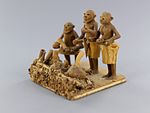Thorn Carving
About this object
History of use
Thorn carvings are miniatures depicting scenes from Nigerian life. This type of carving began circa 1930. Thorns vary in size. They can be as large as 12.7 cm. long and 9.6 cm. wide. They are comparatively soft and easily carved. The light yellow-brown thorn and the dark brown thorn come from the Ata tree; the light red-brown thorn comes from Egun trees. The parts are glued together with viscous paste made from rice cooked with water. They are carved by men.
Cultural context
craft; tourist art
Physical description
Three figures representing people facing a shrine of heads. All figures are holding offerings. Dwarf-like man with beard is holding a skull and a bush cow horn, and he is wearing a short skirt. One man with a beard is holding a stick, and he is wearing knee-length pants with a horn attached to the front of his pants. One woman is holding a skull, and she is wearing a knee-length skirt. The shrine is holding a skull with a horn protruding from the forehead, and a horn held in its mouth, a large flat skull with two horns protruding from the forehead, a small flat skull on top of the head, a round skull with beard, and a stick embedded in top the of the head, and a horn lying on top of the head. Skulls lying on wood chip covered shrine. Heads, arms, legs, large skulls, two small skulls, and horns are dark brown. Clothes and some horns are light yellow-brown. Small skull, stick, and horns are light red-brown. On a wood base.
Categories
Date Made
Before 1972
Date Acquired
8 Feb 1980
How Acquired
Donated
Credit Line
Measurements
Overall: 9.4 cm x 10 cm x 9.5 cm
Object Number
Af352
